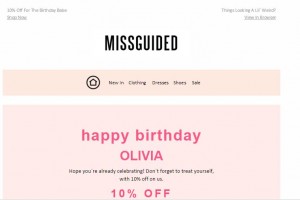So there is something that most of us all receive…emails. Love them or loathe them, they can actually be useful for both the retailer AND the customer.
There are four main types of emails that we receive:
- Life Cycle (e.g. An order confirmation from a company where you have recently bought something)
- E-newsletter (e.g. Offering you something worth reading)
- House-list campaign (e.g. Sales promotion/new products being offered)
- Event Triggered (e.g. Your birthday, Halloween, Christmas)
E-mail marketing and it’s affect on sales
According to Pavlov, Melville, and Plice (2008), ‘E-mail marketing campaigns produce approximately twice the return on investment of the other main forms of online marketing (e.g. web banners) ‘. So, this is evidence that companies really ought to have a strong e-mail marketing strategy, if they want to double the piece of the pie that they can receive from online marketing.
Event Triggered e-mails, what does this actually mean?
In this blog I will be focusing on the Event triggered e-mails that we receive. An event triggered e-mail is a message that is sent to a subscriber on the company’s list, based on an event. For example, a personalized message or discount voucher can be sent to a subscriber on their birthday.
Happy Birthday to you!
Well isn’t this lovely. You sign up to receive e-mails from a company you have dealt with in the past and they send you a message on your birthday. Before I started learning about digital marketing, I always used to marvel and think it was some sort of witch power that companies could actually know when my birthday was?!? FYI, it’s not magic.
Lets all have a little think. Cast your mind back to when you first purchased from a company…For you to buy this product online, it would have been very likely that you have to register an account with them. Now here is where they find out your birthday (among other things). The usual questions get asked: email address, address, & then your date of birth. That is something we all forget.
An example of a Happy Birthday e-mail
It was my birthday in September and I got a few of these kind of e-mails.
I received an e-mail from Missguided, a popular clothing retailer. The e-mail had the following subject line: ‘HAPPY Freakin’ Birthday Olivia’. This way of saying happy birthday, is very relaxed. Perhaps it would be how a friend would say happy birthday to me. This therefore creates a friendly relationship between me and Missguided.
At first instance, I was a little surprised they knew my birthday (but as I noted before, this only lasts a few seconds until I remember how much information we actually give companies).
Did I open it? Yes I did. I think what is different about this event triggered e-mail, as opposed to others (such as ‘Christmas Soon!!!’ or ‘SALE’) is that it was personalised to me. It had my name in the subject line to begin with and then an additional personalisation, with the content saying ‘happy birthday Olivia’.
After the initial greeting of saying Happy Birthday, I was then given a 10% off code especially to me. It all felt very well thought about and I think I thought in my head ‘what can I buy on this shop today?! I have 10% off!’.
Call to action- What does this mean?
Call to action is a part of an e-mail that tells you to do something. In this case, it was the ‘10% Off’ offer that called me to go onto their page. I could also see as I scrolled down, that this offer lasted until the 4th of October (giving me 15 days to redeem this offer).
So after seeing the ‘10% off’, I was then given the code I could use to benefit from this discount. Underneath that, it was signed off ‘Love Missguided x’, following a link to a landing page. A landing page being their website homepage. This link was called ‘Blow Out’- possibly persuading me to have a big blow out of clothes shopping, because it is my birthday! And I can treat myself! All very clever stuff.

Then, as I scrolled down the email, I was shown a picture of a birthday cake.
Which I thought, with the use of flowers and a pretty cake, was a nice way to finish off the e-mail to me, on my birthday.
What I thought worked well
Overall, I thought that this e-mail was a thoughtful way to get me to spend money. Missguided used a few ways to make this email personalised:
- My name
- Wishing me happy birthday
- Signing it off ‘Love Missguided x’- therefore emulating a friendly and kind approach. As if they had sent me a thoughtful birthday card. This evoked a positive feeling from them to me.
- Colour of e-mail- I am a girl, so perhaps they have made it pink and had a flowery background because that gives a more feminine touch.
- Length of e-mail: I thought the length of the e-mail was perfect. To see the whole e-mail, I had to scroll twice. However, to only view the discount code and link to landing page, I didn’t need to scroll at all. This then made it easier for me to see what I could get from this e-mail. This is also supported by research from Ellis-Chadwick, Fiona and Doherty, Neil F. (2012), who interviewed marketing managers, asking them questions about e-mail marketing. One manager said that “If an e-mail is unnecessarily long the customer will switch off”. This therefore supports Missguided, in their decision to make this e-mail no longer than two pages.
What I thought could be improved
- Call to action needs to be more time conscious
With this type of event triggered e-mail, I think call to action is very important here. Missguided sent me the e-mail and gave me 15 days to redeem the discount. Personally, I think that this is too long. I will have read this at the end of the e-mail and thought, ‘half a month is a long time…I have ages to think about what I want to buy with this code’. However, two weeks can go by very quickly and most people would have forgotten. I think to improve, they could make their call to action a little bit more time conscious. If they were to give me a few days, I would then think ‘ahhhh only a few days- I should buy now, to save myself the disappointment!’. This may have then been more useful to them and me, as the consumer.
- Have a link to a more specific landing page
Seeing as it is a birthday e-mail, they could have given a link to a landing page for ‘Party Dresses’. If for example, my birthday was on a Monday, one could assume that I would be going out on the weekend and I would then need something new and special to wear. I would then be able to go straight to their party dresses selection and see if there was something I would want to use my 10% discount on.
What can we learn from all this?
Event triggered e-mails can actually bridge the gap of personal touch, from a huge company to one single consumer. Take the prime example of supermarkets wanting us to know that they work closely with local farmers to produce the food that we buy in their stores. As a consumer, you would feel more comfortable buying products that are grown locally, because it feels like you are supporting these farmers. It is just the same when applied to e-mail marketing. The closer we feel to an organisation or company, the more willing we are to part with our cash to buy their products.
Personalisation and making sure that no-one in the market is getting left behind is very important for companies. Having something as simple as your birth date on their system, can allow them to get you to feel that extra bit special on the one day a year. This could even be worth more than all the other marketing e-mails that you receive on a day to day basis. However, this is the case for all the e-mails that we get sent. Even if they are not event triggered, we still like the personal touch.
Take a look at the link below, to a Guardian article. It explains that personalisation can help a customer make the correct choice for them.
http://www.theguardian.com/media-network/2013/may/31/personalisation-content-choice
References
Ellis-Chadwick, Fiona and Doherty, Neil F. (2012). Web advertising: the role of email marketing. Journal of Business Research, 65(6), pp. 843–848.
Rose (2013), Guardian, ‘Personalisation: helping customers make the right choice’ [Online] <http://www.theguardian.com/media-network/2013/may/31/personalisation-content-choice>
Thanks for reading!
Lordoftheblogs


Leave a Reply